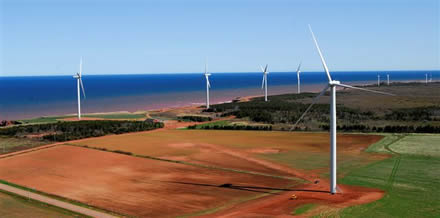Wind Energy R&D Park and Storage System for Innovation in Grid Integration
Lead proponent: Wind Energy Institute of Canada (WEICan)
Location: Prince Edward Island
CEF contribution: $ 12 M
Project total: $ 24.8 M
Project Background:

WEICan’s Wind Farm, PEI, Canada
As the percentage of wind generated electricity increases in Canada and around the globe, the impact of large amounts of wind energy on electrical grids has become a more important and complex issue. On Prince Edward Island (PEI), a high percentage of the island’s load is supplied by wind energy. In 2013, the province’s utility Maritime Electric Company Limited (MECL) reported that 17% of its load was supplied by wind energy. The city of Summerside, which operates the only municipally-owned electric utility on the island, produced 24% of its load from its wind 12 MW wind farm that year. PEI has a total of 204 MW of installed wind capacity. This high concentration of wind energy, supplies a load which fluctuates between 90 and 260 MW, creating a constant mismatch of supply and demand.
Energy storage has a large role to play in integrating wind generated electricity, stabilizing the electrical grid and maximizing energy production. Along with time-shifting wind power to a time when it is needed, storage can provide a variety of other services which will ensure the security of supply. Storage can be used to ensure voltage levels along lines, reduce distribution and transmission losses, and provide backup power at substations.
The Wind Energy Institute of Canada (Institute) in PEI recognized the need to further explore energy storage technologies, and provide installation and operational information to system operators, utilities and other stakeholders. The project “Wind R&D Park and Storage System for Innovation in Grid Integration”, led by the Institute, was awarded $12M from the Clean Energy Fund.
Results:
Five DeWind D9.2, 2 MW wind turbines were installed on the Institute’s 38-acre site in North Cape, PEI. Each turbine has a synchronous generator, which ensures grid stability by providing inertia to the electrical grid, responding positively to voltage dips, and providing grid support to the electrical network. The turbines were commissioned in April 2013, and in that fiscal year, they produced 39,332 MWh. In February of 2014, the Battery Energy Storage System (BESS) was put into operation. The BESS is composed of two primary components - a power conversion system supplied by S&C Electric Canada Ltd. (S&C) via its PureWave® Storage Management System (SMS), and battery modules supplied by General Electric (GE). The batteries are based on GE’s sodium nickel chloride Durathon modules and they represented the first such installation for GE in Canada. The PureWave SMS converts the energy generated by the wind turbines to direct current, which charges the batteries. When called upon, PureWave SMS will reverse the flow to take the energy from the batteries and convert it into alternating current for use by the utility, MECL, for sale to retail customers.
For the first several months of operation, the BESS was operated in primarily a time-shifting mode, charging in nighttime hours when wind was predicted to be available and discharging during evening peak hours. This allowed the utility to become familiar with the charge and discharge cycles, and the resulting effects on voltage. The wind turbines were able to help maintain system voltage despite the consumption of reactive power by the other wind turbines connected to the same 69 kV lines. Moreover, the turbines operated at a high capacity factor, and their availability increased their reliability and therefore their integration potential into the network.
Benefits to Canada:
By demonstrating the practical application for energy storage systems, it is anticipated that the acceptance and utilization of such systems will allow the integration of more renewable energy by utilities into their generation mix.
Next Steps:
Further demonstrate operational processes and control concepts that result in economic and operational performance benefits to the electric grid system, as well as maximize the positive environmental impact of the wind turbine operation.
Find out more
Page details
- Date modified: